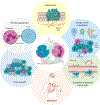Small extracellular vesicle-mediated bidirectional crosstalk between neutrophils and tumor cells
- PMID: 34479816
- PMCID: PMC9235060
- DOI: 10.1016/j.cytogfr.2021.08.002
Small extracellular vesicle-mediated bidirectional crosstalk between neutrophils and tumor cells
Abstract
Neutrophils are the first line of defense against tissue injury and play an important role in tumor progression. Tumor-associated neutrophils (TANs) mediate pro-tumor immunosuppressive activity and their infiltration into tumors is associated with poor outcome in a variety of malignant diseases. The tumor cell-neutrophil crosstalk is mediated by small extracellular vesicles (sEVs) also referred to as exosomes which represent a major mechanism for intercellular communication. This review will address the role of neutrophil-derived sEVs (NEX) in reprogramming the TME and on mechanisms that regulate the dual potential of NEX to promote tumor progression on one hand and suppress tumor growth on the other. Emerging data suggest that both, NEX and tumor-derived sEVs (TEX) carry complex molecular cargos which upon delivery to recipient cells in the tumor microenvironment (TME) modulate their behavior and reprogram them to mediate pro-inflammatory or immunosuppressive responses. Although it remains unknown how the balance between the often conflicting signaling of TEX and NEX is regulated, this review is an attempt to provide insights into mechanisms that underpin this complex bidirectional crosstalk. A better understanding of the signals NEX process or deliver in the TME might lead to the development of novel approaches to the control of tumor progression in the future.
Keywords: Neutrophils; Small extracellular vesicles; Tumor microenvironment (TME); Tumor-associated neutrophils (TAN); Tumor-derived exosomes (TEX).
Copyright © 2021. Published by Elsevier Ltd.
Conflict of interest statement
Conflict of interest
Authors declare no conflict of interest.
Figures




References
Publication types
MeSH terms
Grants and funding
LinkOut - more resources
Full Text Sources

